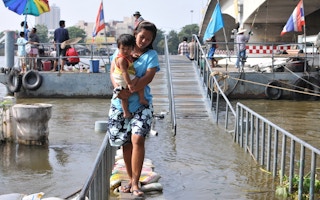The impacts of climate change will disproportionately affect people living in poverty in poorer countries, notwithstanding their minimal per-capita contributions to greenhouse-gas emissions. It’s here where the damage will be greatest and where people have the lowest capacity to cope.
According to UN Women, some 70 per cent of people in the developing world living below the poverty threshold are women, yet gender issues receive little attention in the climate-change debate. People are vulnerable to the hazards of climate change to a greater or lesser degree depending on factors such as their wealth, education, skills, management capability and access to technology, infrastructure and information. Women’s access to these resources is often inferior to that of men, and this increases their vulnerability and limits their ability to cope with the advent of climate shocks and to recover when they have passed.
These gender-related inequalities are particularly pervasive in the developing world. Women and children are 14 times more likely to die than men during natural disasters. More than 70 per cent of the dead from the Asian tsunami were women; roughly 87 per cent of unmarried women and 100 per cent of married women lost their main source of income when Cyclone Nargis hit the Ayeyarwaddy Delta in Myanmar in 2008.
In Bangladesh, social prejudice keeps girls and women from learning to swim and climb trees. Many women cannot leave their homes without accompaniment or consent from their husband or one of their male relatives. Men can more easily warn each other as they meet in public spaces, but they rarely communicate information to the rest of the family. As a result, far more women than men perish in the major floods which characterise life in the coastal areas of Bangladesh. When a cyclone and floods hit Bangladesh in 1991, the death rate for women was almost five times higher than for men.
Research by the London School of Economics found that in a sample of 141 countries over the period 1981–2002, natural disasters (and their subsequent impact) killed on average more women than men, and killed women at an earlier age than men. Boys were more likely to receive preferential treatment in rescue efforts, and women and children suffered more from food shortages and a lack of privacy and safety in the aftermath of disasters.
In India, various studies have shown that over the past decade more women than men have suffered from premature deaths on account of heatwaves and cold snaps and other climate-related extreme events. Following extreme events such as storms and floods, the burden of devastation also falls primarily on women, who must keep the family together.
Changing weather patterns could affect farming activities such as paddy cultivation in Asia, and cash crops such as cotton and tea, the cultivation of which employs many women. In Africa, for example, women contribute to 70 per cent of food production; they account for nearly half of all farm labour and 80–90 per cent of food processing. Wangari Maathai acknowledged this when she received the Nobel Peace Prize in Oslo on 10 December, 2004, describing Africa’s women as “the primary caretakers, holding significant responsibility for tilling the land and feeding their families”.
In Bangladesh, women and children provide nearly all household water in rural areas, both for domestic use such as drinking, cooking, bathing and washing, and for irrigating gardens and watering livestock. The intrusion of saltwater into freshwater resources in the districts of Satkhira, Khulna and Bagerhat on the south-western coast of Bangladesh is already having a disproportionate impact on women, particularly during the dry season. Because nearly all local water sources have high salinity, women must travel long distances by foot every day to find drinking water, even if they are in poor health.
“
This lack of representation must change, because climate-change policies will be unsuccessful if women have no opportunity to influence decision-making, build their capacity, lower their vulnerability and diversify their income sources.
Ensuring greater gender equality will benefit society as a whole and help promote sustainable development. However, getting gender issues into debates on climate change and sustainable development is happening piecemeal, extremely slowly and often as an afterthought.
This is in part due to the lack of participation by women in decision-making at all levels. In the Kilombera district in Tanzania, for example, a newly constructed well dried up. Its location had been determined by an all-male local committee, despite the fact that it was the task of local women to dig for water by hand as they know the most likely places to find water. By the same token, at the international climate-change negotiations in 2010, women made up only 30 per cent of negotiators and just 10 per cent of heads of delegations.
This lack of representation must change, because climate-change policies will be unsuccessful if women have no opportunity to influence decision-making, build their capacity, lower their vulnerability and diversify their income sources. In India, for example, women have played a huge role in improving the public service health sector. A 1992 constitutional amendment mandated the reservation of one-third of panchayat (local government) seats for women. Since then, relative spending on public water and latrines for low-caste communities has increased.
Special attention needs to be paid to the opportunities arising from international climate-change negotiations. Many emerging solutions intended to help people cope with climate change involve land use and agriculture in rural areas, a key sector for women.
The dependence of women on biomass energy – for example, burning wood for household cooking – means that they should also be involved in projects promoting renewable-energy resources. In El Salvador and Guatemala the primary source of fuel is wood, and it is the job of women and girls to gather it. Many spend as much as three or four hours, three to five times a week, searching for wood. And when they cook food for their households, they are exposed to toxic cooking smoke.
Agencies promoting clean, renewable energy, such as solar ovens, have found it vital to target groups of women, who can learn from one another whilst practising the new technologies. Despite this, men often influence the uptake of new-energy technologies in this domain too. In one case in Zimbabwe, men are reported to have rejected the use of solar cookers by their wives, since technology and its development are seen traditionally as a male preserve.
Hannah Reid is consulting researcher, International Institute for Environment and Development (IIED). This post originally appeared on TheThirdPole.net.


















